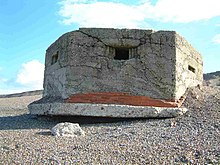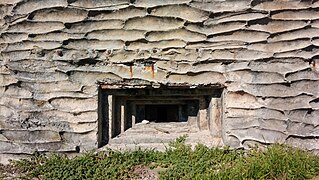
The Maginot Line, named after the French Minister of War André Maginot, is a line of concrete fortifications, obstacles and weapon installations built by France in the 1930s to deter invasion by Nazi Germany and force them to move around the fortifications.
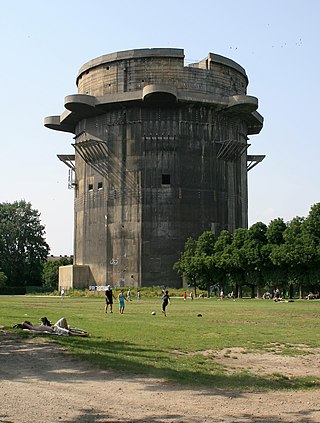
A bunker is a defensive military fortification designed to protect people and valued materials from falling bombs, artillery, or other attacks. Bunkers are almost always underground, in contrast to blockhouses which are mostly above ground. They were used extensively in World War I, World War II, and the Cold War for weapons facilities, command and control centers, and storage facilities. Bunkers can also be used as protection from tornadoes.

Trench warfare is a type of land warfare using occupied lines largely comprising military trenches, in which combatants are well-protected from the enemy's small arms fire and are substantially sheltered from artillery. It became archetypically associated with World War I (1914–1918), when the Race to the Sea rapidly expanded trench use on the Western Front starting in September 1914.
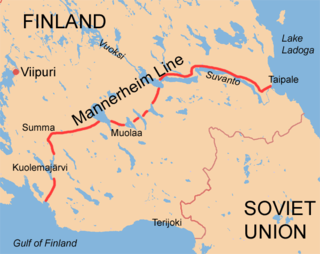
The Mannerheim Line was a defensive fortification line on the Karelian Isthmus built by Finland against the Soviet Union. While this was never an officially designated name, during the Winter War it became known as the Mannerheim Line, after Finnish Army's then commander-in-chief Field Marshal Baron Carl Gustaf Emil Mannerheim. The line was constructed in two phases: 1920–1924 and 1932–1939. By November 1939, when the Winter War began, the line was by no means complete.

A blockhouse is a small fortification, usually consisting of one or more rooms with loopholes, allowing its defenders to fire in various directions. It is usually an isolated fort in the form of a single building, serving as a defensive strong point against any enemy that does not possess siege equipment or, in modern times, artillery, air force and cruise missiles. A fortification intended to resist these weapons is more likely to qualify as a fortress or a redoubt, or in modern times, be an underground bunker. However, a blockhouse may also refer to a room within a larger fortification, usually a battery or redoubt.

The Alpine Line or Little Maginot Line was the component of the Maginot Line that defended the southeastern portion of France. In contrast to the main line in the northeastern portion of France, the Alpine Line traversed a mountainous region of the Maritime Alps, the Cottian Alps and the Graian Alps, with relatively few passes suitable for invading armies. Access was difficult for construction and for the Alpine Line garrisons. Consequently, fortifications were smaller in scale than the fortifications of the main Line. The Alpine Line mounted few anti-tank weapons, since the terrain was mostly unsuitable for the use of tanks. Ouvrage Rimplas was the first Maginot fortification to be completed on any portion of the Maginot Line, in 1928. The Alpine Line was unsuccessfully attacked by Italian forces during the Italian invasion of France in 1940. Following World War II, some of the larger positions of the Alpine Line were retained in use through the Cold War.

Beacon Hill Battery is a late-19th and 20th century coastal fortification that was built to defend the port of Harwich, Essex. It is a scheduled ancient monument.

The fortifications of Metz, a city in northeastern France, are extensive, due to the city's strategic position near the border of France and Germany. After the Franco-Prussian War of 1870, the area was annexed by the newly created German Empire in 1871 by the Treaty of Frankfurt and became the Reichsland Alsace–Lorraine. The German Army decided to build a fortress line from Mulhouse to Luxembourg to protect their new territories. The centerpiece of this line was the Moselstellung between Metz and Thionville, in Lorraine.

The Koningshooikt–Wavre Line, abbreviated to KW Line and often known as the Dyle Line after the Dijle (Dyle) river, was a 60 kilometres (37 mi)-long fortified line of defence prepared by the Belgian Army between Koningshooikt and Wavre which was intended to protect Brussels from a possible German invasion. Construction on the KW Line began in September 1939 after World War II had begun but while Belgium itself remained a neutral state. It was subsequently extended southwards from Wavre towards Namur. The line itself consisted of bunkers, anti-tank ditches, and barricades including so-called Cointet-elements and played a key role in Allied strategy during the German invasion of Belgium in May 1940. However, its role in the actual fighting was ultimately minimal. In 2009 an inventory of surviving emplacements was begun.

British hardened field defences of World War II were small fortified structures constructed as a part of British anti-invasion preparations. They were popularly known as pillboxes, a reference to their shape.
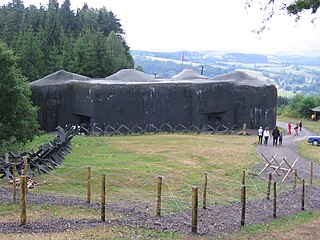
Czechoslovakia built a system of border fortifications as well as some fortified defensive lines inland, from 1935 to 1938 as a defensive countermeasure against the rising threat of Nazi Germany. The objective of the fortifications was to prevent the taking of key areas by an enemy—not only Germany but also Hungary and Poland—by means of a sudden attack before the mobilization of the Czechoslovak Army could be completed, and to enable effective defense until allies—Britain and France, and possibly the Soviet Union—could help.

Ouvrage Cap Martin is a work of the Maginot Line's Alpine extension, the Alpine Line, also called the Little Maginot Line. The ouvrage, located on high ground in Roquebrune, consists of two artillery blocks and one combination block facing Italy. The ouvrage was at the southernmost end of the Alpine Line and overlooked the Mediterranean Sea coastline at an altitude of 21 meters between Nice and Menton, facing towards Italy. The ouvrage and its advance casemate at Pont Saint Louis controlled the coastal roads along the Mediterranean.

The Fort de Guentrange dominates Thionville in the Moselle department of France. It was built by Germany next to the town of the same name in the late 19th century after the annexation of the Moselle following the Franco-Prussian War. The Fort de Guentrange was part of the Moselstellung, a group of eleven fortresses surrounding Thionville and Metz to guard against the possibility of a French attack aimed at regaining Alsace and Lorraine, with construction taking place between 1899 and 1906. The fortification system incorporated new principles of defensive construction to deal with advances in artillery. Later forts, such as Guentrange, embodied innovative design concepts such as dispersal and concealment. The later forts were designed to support offensive operations, as an anchor for a pivoting move by German forces into France.
The Fort de Koenigsmacker is a fortification located to the northeast of Thionville in the Moselle department of France. It was built by Germany next to the town of the same name in the early 20th century after the annexation of the Moselle following the Franco-Prussian War. The Fort de Koenigsmacker was part of the Moselstellung, a group of eleven fortresses surrounding Thionville and Metz to guard against the possibility of a French attack aimed at regaining Alsace and Lorraine, with construction taking place between 1908 and 1914. The fortification system incorporated new principles of defensive construction to deal with advances in artillery. Later forts, such as Koenigsmacker, embodied innovative design concepts such as dispersal and concealment. These later forts were designed to support offensive operations, as an anchor for a pivoting move by German forces into France.
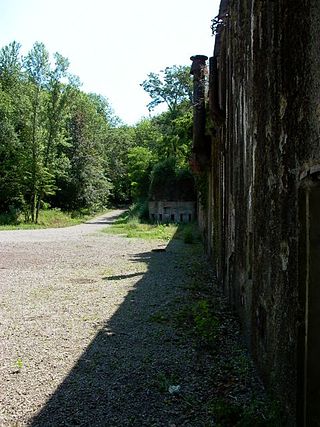
The Fort d'Illange is a fortification located to the south of Thionville in the Moselle department of France. It was built by Germany next to the town of Illange in the early 20th century after the annexation of the Moselle following the Franco-Prussian War. The Fort d'Illange was part of the Moselstellung, a group of eleven fortresses surrounding Thionville and Metz to guard against the possibility of a French attack aimed at regaining Alsace and Lorraine, with construction taking place between 1905 and 1911. The fortification system incorporated new principles of defensive construction to deal with advances in artillery. Later forts, such as Illange, embodied innovative design concepts such as dispersal and concealment. These later forts were designed to support offensive operations, as an anchor for a pivoting move by German forces into France.

Ouvrage La Ferté, also known as Ouvrage Villy-La Ferté, is a petit ouvrage of the Maginot Line, located in the Fortified Sector of Montmédy, facing Belgium. The ouvrage lies between the towns of Villy and La Ferté-sur-Chiers. It possesses two combat blocks linked by an underground gallery. The westernmost position in its sector, it was a comparatively weakly armed fortification in an exposed position that left it vulnerable to isolation and attack. After a sustained attack during the Battle of France, the position was overwhelmed by German forces and was destroyed with its entire garrison killed. The fighting at La Ferté was the heaviest of any position in the Maginot Line. It is preserved as a war memorial.

The Fortified Sector of Montmédy was the French military organisation that in 1940 controlled the section of the Maginot Line between Sedan and Longuyon, a distance of about 60 kilometres (37 mi). The sector was not as strongly defended as other sections of the Maginot Line, facing the southern Ardennes region of Belgium. Large portions of the Montmédy sector were defended by fortified houses, blockhouses or casemates. The sector includes only four ouvrages of the type found in stronger sections of the Line. The weakly defended area in front of Sedan was the scene of a major breakthrough by German forces in the opening of the Battle of France. This was followed by a German assault on the Maginot Ouvrage La Ferté, which killed the entire garrison, the only such event on the Maginot Line.
The Fortified Sector of Lille was the French military organization that in 1940 controlled the section of the French border with Belgium opposite Lille. The sector was part of a system of fortifications that included the Maginot Line in other sectors. In the case of the Lille sector, no large fortifications of the kind typified by the Maginot Line were built in the area. Fortifications were confined to a total of 65 blockhouses and 23 infantry shelters within a few kilometers of the border, mainly between Roubaix and Tourcoing and the border. The Fortified Sector of Lille was bordered on the east by the Fortified Sector of the Escaut and on the west by the Fortified Sector of Flanders. The sector figured in the Pillbox affair of 1939-40. It was quickly overrun by German forces during the Battle of France.
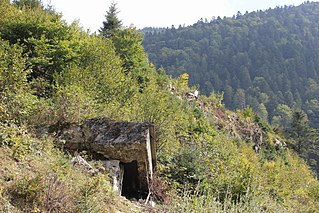
The Árpád Line was a line of fortifications built in 1941-44 in the north-eastern and eastern Carpathian Mountains, along the border of Kingdom of Hungary. It was named after Árpád, the head of the Hungarian tribes. The main function of the Line was to protect Northern Transylvania and Carpathian Ruthenia from the east.

The flexible defense is a military theory about the design of modern fortifications. The examples of "flexible" defense-lines are not based on dense lines of heavily armed, large and expensive concrete fortifications as the systems such as the Maginot Line were. Their protective capacity hinges on multiple lines of obstacles and small shelters fitting into the environment. They are "flexible" because soldiers are not locked in pillboxes, but fight instead in easily replaceable open earth-wood made positions, while bunkers serve only as shelters during bombardments. As a result, they are able to adapt to the opponent's movements, and there are no easily targeted large buildings in these lines.


